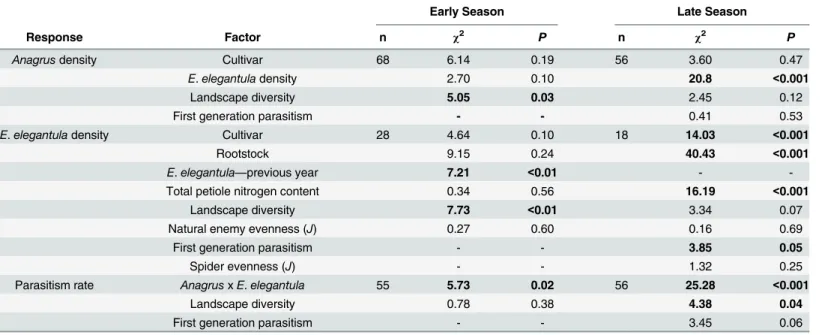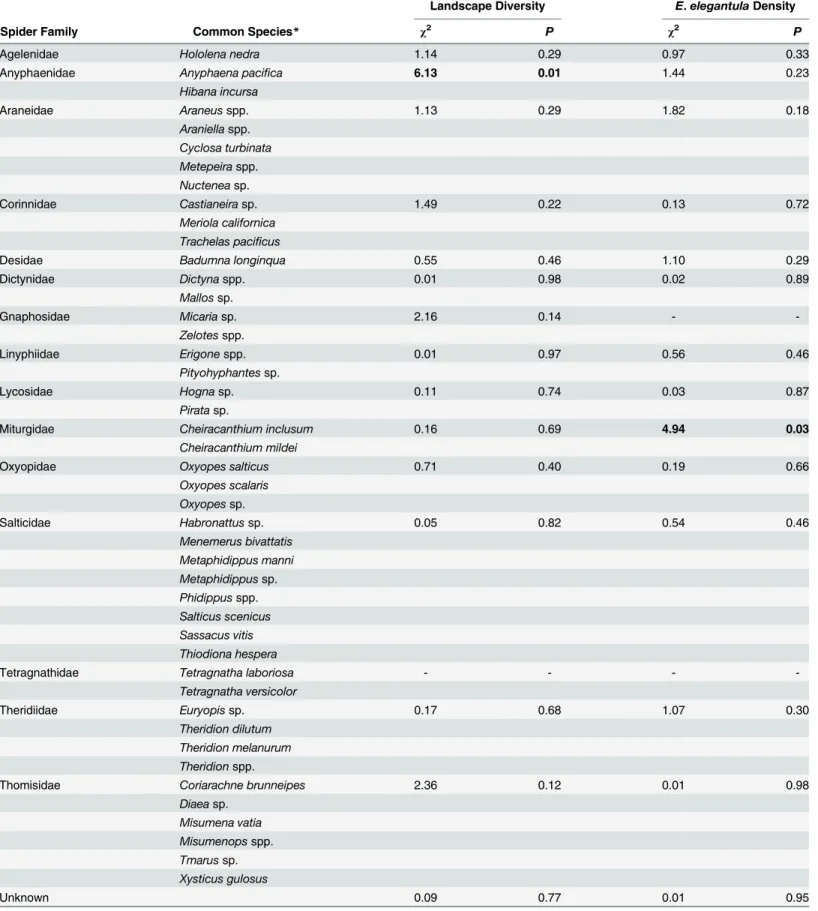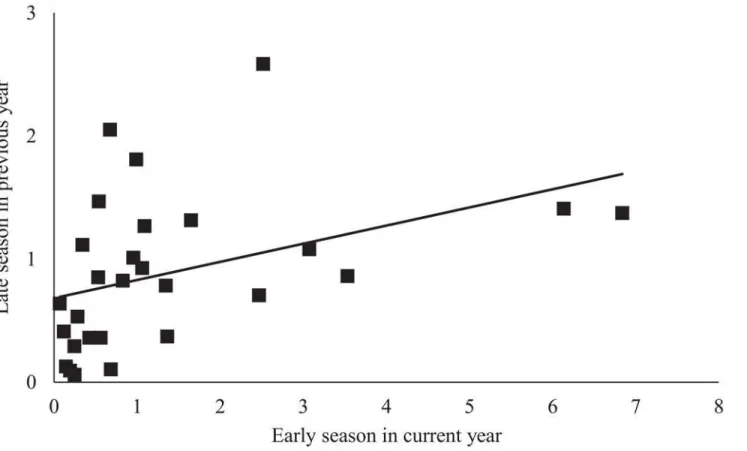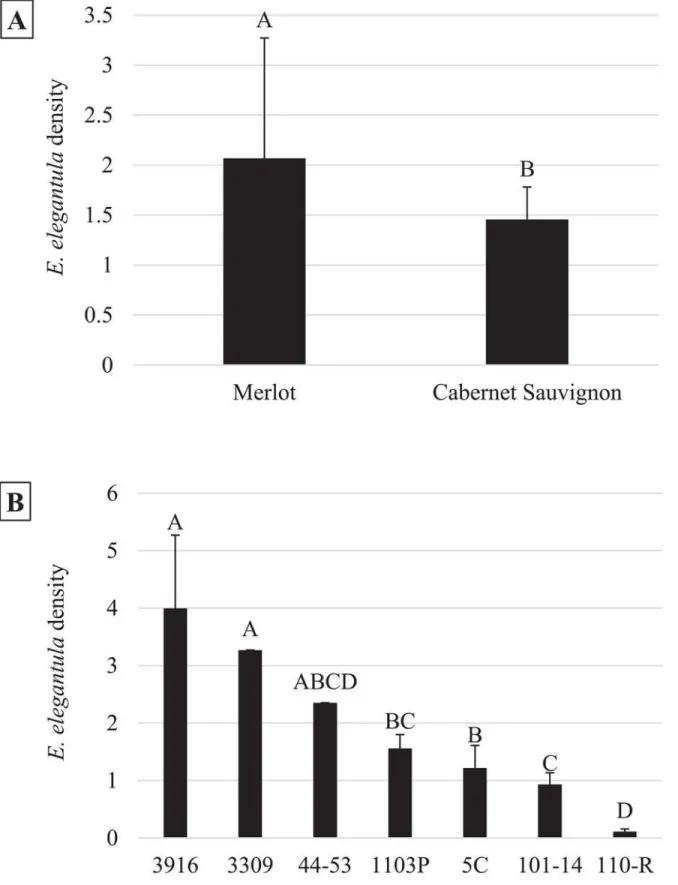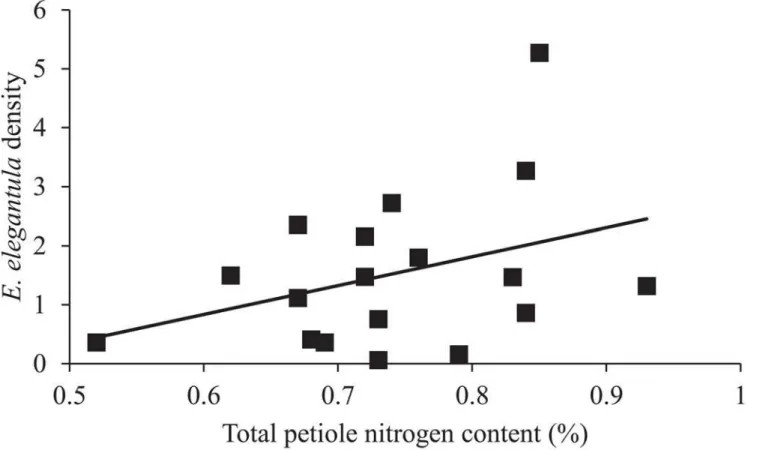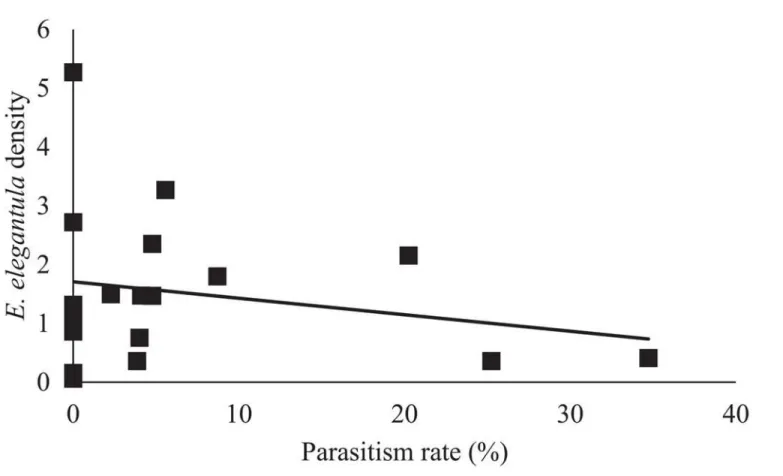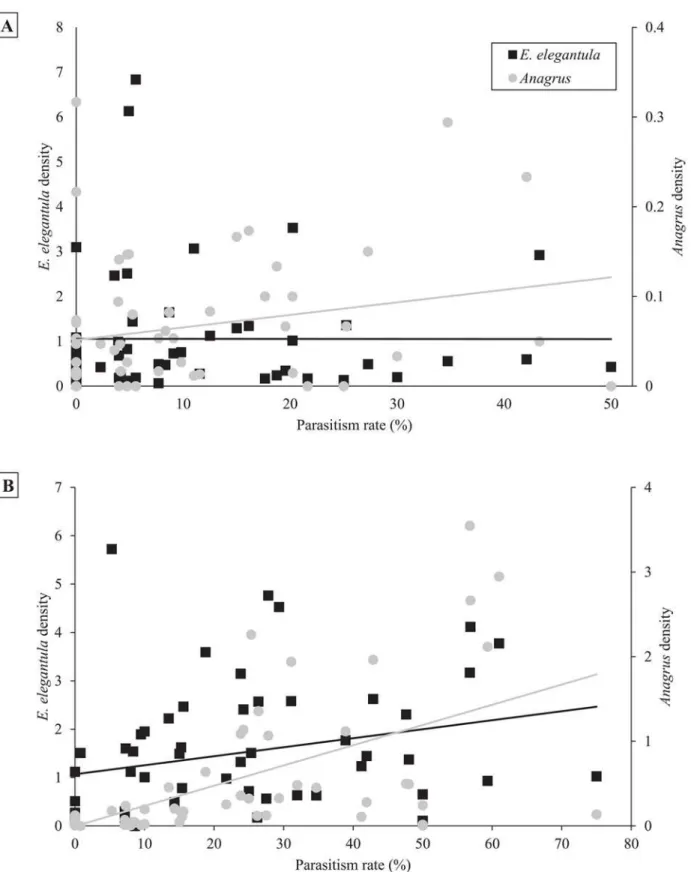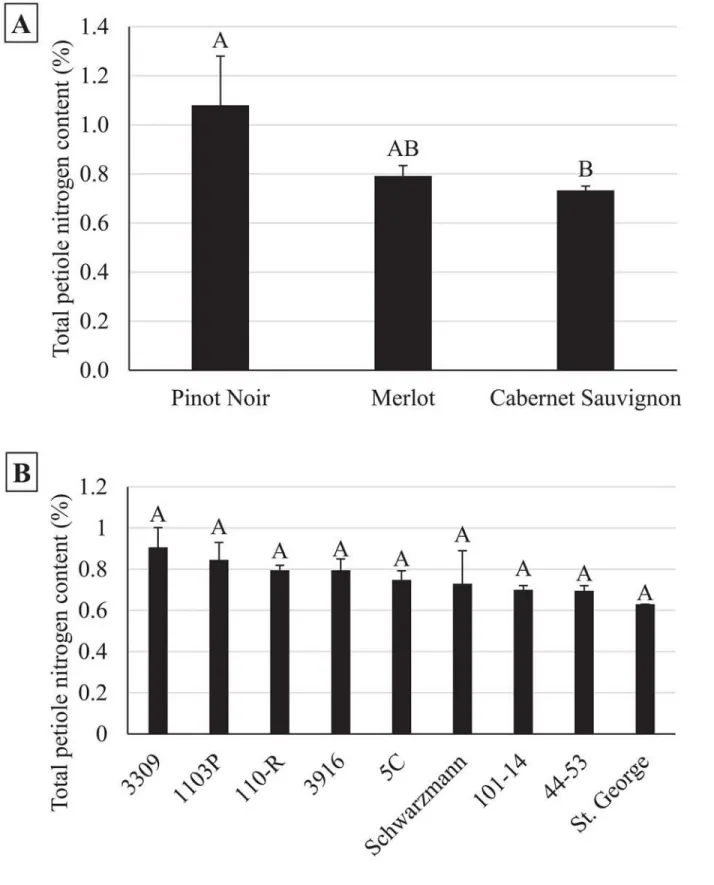Landscape Diversity and Crop Vigor Influence
Biological Control of the Western Grape
Leafhopper (E.
elegantula
Osborn) in
Vineyards
Houston Wilson*, Albie F. Miles¤, Kent M. Daane, Miguel A. Altieri
Department of Environmental Science, Policy and Management, University of California, Berkeley, California, United States of America
¤ Current address: Division of Social Sciences, University of Hawai’i, West O’ahu, Kapolei, Hawaii, United States of America
*houston@berkeley.edu
Abstract
This study evaluated how the proportional area of natural habitat surrounding a vineyard (i.e. landscape diversity) worked in conjunction with crop vigor, cultivar and rootstock selec-tion to influence biological control of the western grape leafhopper (Erythroneura elegantula
Osborn). The key natural enemies ofE.elegantulaareAnagrus erythroneuraeS. Trjapitzin
& Chiappini andA.daaneiTriapitsyn, both of which are likely impacted by changes in
land-scape diversity due to their reliance on non-crop habitat to successfully overwinter. Addi-tionally,E.elegantulais sensitive to changes in host plant quality which may influence
densities on specific cultivars, rootstocks and/or vines with increased vigor. From 2010– 2013, data were collected on natural enemy and leafhopper densities, pest parasitism rates and vine vigor from multiple vineyards that represented a continuum of landscape diversity. Early in the season, vineyards in more diverse landscapes had higherAnagrusspp.
densi-ties and lowerE.elegantuladensities, which led to increased parasitism ofE.elegantula.
Although late season densities ofE.elegantulatended to be lower in vineyards with higher
early season parasitism rates and lower total petiole nitrogen content, they were also affected by rootstock and cultivar. While diverse landscapes can support higher natural enemy populations, which can lead to increased biological control, leafhopper densities also appear to be mediated by cultivar, rootstock and vine vigor.
Introduction
Natural habitats are an important source of ecosystem services to agriculture, including biolog-ical control of crop pests [1–3]. By providing important resources for natural enemies, such as refugia, overwintering habitat, nectar, pollen and alternate hosts or prey, non-crop habitats can support natural enemy populations in nearby crop fields, which can lead to increased levels of biological control of pests [4]. As such, changes in the area, density and species composition of OPEN ACCESS
Citation:Wilson H, Miles AF, Daane KM, Altieri MA (2015) Landscape Diversity and Crop Vigor Influence Biological Control of the Western Grape Leafhopper (E.elegantulaOsborn) in Vineyards. PLoS ONE 10 (11): e0141752. doi:10.1371/journal.pone.0141752
Editor:S. Kaan Kurtural, Fresno, UNITED STATES
Received:June 22, 2015
Accepted:October 13, 2015
Published:November 10, 2015
Copyright:© 2015 Wilson et al. This is an open access article distributed under the terms of the
Creative Commons Attribution License, which permits unrestricted use, distribution, and reproduction in any medium, provided the original author and source are credited.
Data Availability Statement:Data have been deposited to Dryad:http://dx.doi.org/10.5061/dryad. c1m0p.
Funding:This work was supported by grants to HW from the Robert Van den Bosch Memorial Scholarship.
natural habitats surrounding an agroecosystem can impact natural enemy diversity and abun-dance and their subsequent impact on crop pests, but outcomes are typically asymmetric due to differences in natural enemy dispersal ability and the degree to which a given species relies on non-crop resources [5–7].
Herbivore performance can also be strongly influenced by structural and chemical charac-teristics of the host-plant itself, which in agriculture is largely determined by crop cultivar and vigor, and in the case of woody perennial crops rootstock selection as well [8–10]. Of course, host-plant quality can also be influenced by environmental conditions, such as ambient tem-perature and water status. Trichomes and leaf hairs are a structural defense that interfere with insect movement [11] while the production of certain secondary metabolites in plant tissue that are toxic to herbivores act as a chemical defense [12,13]. These traits are not exclusive, for instance glandular trichomes combine both structural and chemical defenses [14]. The pres-ence or abspres-ence of such traits associated with a specific crop cultivar or rootstock can be a strong determinant of pest densities regardless of natural enemy impact [15].
Furthermore, changes in crop vigor can alter secondary plant metabolites in a way that can be beneficial to insect herbivores. The plant stress hypothesis suggests that reduced metabolism in drought stressed plants can lead to increased concentrations of soluble nitrogen in plant tis-sue and/or decreased production of chemical defense compounds, both to the benefit of herbi-vores [16,17]. Alternately, the plant vigor hypothesis states that overly vigorous plants are also more preferable to insects due to the increased quality of newly developed tissue [18]. Crop vigor can be influenced by a number of factors, including soil fertility and moisture [19] as well as crop cultivar and rootstock selection [20–23]. Rootstocks in particular play an important role, as they mediate uptake of nutrients and water, as well as synthesis of key plant hormones [24]. Previous studies have demonstrated that herbivore preference and performance can be influenced by rootstock selection, this of course includes root feeding insects [25–27] but the effect extends to foliar feeders as well [28–30].
The western grape leafhopper (Erythroneura elegantulaOsborn [Hemiptera: Cicadellidae]) is a key pest of wine grapes in California’s North Coast region. The adults overwinter in repro-ductive diapause, commonly inhabiting leaf litter or perennial vegetation found in and around the vineyard. Adults become active in the spring and, after feeding on fully expanded mature grape leaves, they break their reproductive diapause, mate and then the females begin to ovi-posit into grape leaves. In this wine grape region,E.elegantulatypically completes two genera-tions per year before grape vines senesce and the adults enter diapause and move back onto the vineyard floor [31].
The key parasitoids ofE.elegantulaareAnagrus erythroneuraeS. Trjapitzin & Chiappini
andA.daaneiTriapitsyn (Hymenoptera: Mymaridae). Both species attack the eggs ofE.
elegan-tulaas well as those of closely related leafhoppers. Spiders are the most abundant generalist predator in vineyards [32]. A number of additional generalist predators are also known to feed
onE.elegantulaeggs, nymphs and/or adults, including soldier beetles (Cantharidae), minute
pirate-bugs (Oriussp.), green lacewings (Chrysoperlasp.), convergent lady beetle (Hippodamia
convergens[Guérin-Méneville]), big-eyed bugs (Geocorissp.), brown lacewings (Hemerobius
sp.), damsel bugs (Nabissp.), and hover fly larva (Syrphidae) [31]. Although generalist preda-tors, and spiders in particular, can have an impact onE.elegantuladensities [33,34],Anagrus
wasps are considered the dominant biological control agent in this system.
Anagrusbetween cultivated wine grapes (where they attackErythoneuraspp. from April— Sep-tember) and natural habitats (where they attack alternate leafhopper hosts to overwinter from October—March). Insufficient overwintering habitat near the vineyard for these alternate leaf-hopper hosts could result in the later arrival and/or lower abundance ofAnagruswasps colo-nizing the system each year, which could in turn have negative implications for biological control ofE.elegantula.
While a number of studies have evaluated the influence of adjacent patches of natural and semi-natural habitat (e.g., French prunes) on natural enemies and biological control of vine-yard leafhoppers [38–42] only a few have evaluated the influence of landscape diversity on nat-ural enemies [43–46], and none have measured natural enemy impact on leafhoppers. The aim of this study was to evaluate whether or not natural enemy populations and biological control
ofE.elegantulaare influenced by changes in the proportion of natural habitat surrounding the
vineyard; however, the analyses also considered the effects of grape cultivar, rootstock and vine vigor onE.elegantuladensities. This was achieved by collecting data over a four year period (2010–2013) onE.elegantulaand natural enemy densities, parasitism rates and vine vigor from 33 vineyards that represented a continuum of landscape diversity in one geographic area. Data generated from this study will provide insight into the key factors driving the relationship between landscape diversity and biological control ofE.elegantulain vineyards.
Materials and Methods
Study Sites
Field sites consisted of vineyard blocks>0.4 hectares (1 acre) located in Napa and Sonoma
County, California, USA. There were 21, 25, 17, and 7 sites in 2010, 2011, 2012, and 2013, respectively. The vineyards were situated in low, intermediate and high diversity landscapes, as measured by the relative proportion of non-crop natural habitat within 0.5 km. Permission to access all vineyard sites was given by the land owners.
All vineyard blocks were located on flat, level ground and consisted of vines that were red cultivars at least five years old. Cultivars were mostly Cabernet Sauvignon but also included Merlot, Pinot Noir, Zinfandel and Petit Verdot. Rootstocks included 101–14, 5C, O39-16, 3309C, St. George, 44-53M, 110-R, 1103P and Schwarzmann. Specific cultivar-rootstock com-binations at the study sites can be found inTable 1. The vigor of these cultivars and rootstocks varies and the cultivars also exhibit differences in leaf hair density, two factors that can influ-ence leafhopper host-plant preferinflu-ence. SeeTable 2for details about these key characteristics for the cultivars and rootstocks in this study. Each experimental block was comprised of 40–80 vine rows with 50–80 vines per row. All samples were taken from 5 vine rows in the middle of the block. Within each of the sample rows no measurements were taken from the first or last ten vines.
Throughout the course of the study no insecticides targeting leafhoppers or other pierce-suck pests were used at any of the study sites. Insecticides were applied at a subset of sites as part of a mandatory eradication program for the invasive European grapevine berry moth (Tortricidae:Lobesia botranaDenis & Schiffenmüller) in 2010–2012 [48]. These sprays took place at 10 of the 21 sites in 2010, 14 of the 25 sites in 2011, 17 of the 17 sites in 2012, and 0 of the 7 sites in 2013. All sprays consisted of non-contact products, including insect growth regu-lators, diamides, microbial insecticides (e.g.Bacillus thurigiensis), avermectins and spinosyns. With the exception of spinosyns, these pesticides have low natural enemy toxicity [49]. While spinosyns can be moderately toxic to parasitoids [50], their use was restricted to just one spray at one of the study sites in 2010 and 2011. All of these products have little to no impact onE.
Quantification of Landscape Diversity
Landscape diversity was quantified by extracting“rangeland cover type”from the CalVEG dataset (USDA Forest Service Remote Sensing Lab) using ArcGIS 10.1 (ESRI, Redlands, USA). There were 71 possible values for rangeland cover type, as described by Shiflet [51]. The total area of each cover type was calculated within a 500 m radius around each vineyard site. Cover types were then consolidated into five categories:“natural habitat”,“agriculture”,“ develop-ment”,“water”and“no data”. The“natural habitat”category consisted primarily of riparian, oak woodland and chaparral habitats while the“agriculture”category was almost entirely vine-yard.“Development”included all commercial and residential areas, including urban vegetative landscaping. For this analysis,“landscape diversity”is defined as the percentage of“natural habitat”within 500 m of the vineyard study site.
Insect Abundance and Parasitism Rate
Natural enemy andE.elegantulaadult abundance. Yellow sticky-traps were used to monitor the abundance ofAnagruswasps, key generalist predators andE.elegantulaadults in the early season (April 29–June 4 2010; April 13–May 25 2011; April 24–June 6 2012; April 12–May 22 2013) and late season (July 6–August 18 2010; July 14–September 7 2011; July 10
Table 1. Key Characteristics of Cultivars and Rootstocks at the Study Sites [47].
Cultivar / Rootstock VitisParentage Vigor Leaf Hairs
Cabernet Sauvignon vinifera High Sparse
Merlot vinifera Medium—High Sparse
Pinot Noir vinifera Low—Medium Dense
Petit Verdot vinifera Medium—High Dense
Zinfandel vinifera Medium Dense
101–14 Mgt ripariaxrupestris Medium
-110R berlandierixrupestris Medium
-1103P berlandierixrupestris Medium—High
-3309C ripariaxrupestris Medium
-44-53M ripariax (cordifoliaxrupestris) Medium
-5C berlandierixriparia Low—Medium
-O39-16 viniferaxrotundifolia High
-Schwarzmann ripariaxrupestris Medium
-St. George rupestris High
-doi:10.1371/journal.pone.0141752.t001
Table 2. Number of Study Sites with Specific Cultivar-Rootstock Combinations.
Merlot Cabernet Sauvignon Pinot Noir Petit Verdot Zinfandel
5C 5 4
O39-16 2
3309C 2 1 1
St. George 2 2
101–14 Mgt 1 6 1 1
44-53M 1
Schwarzmann 1
110R 2 1
1103P 1
–August 21 2012; July 14–August 28 2013). These early and late season periods approximately coincided with the peak adult flight period for first and second generationE.elegantula popula-tions. At each vineyard, five yellow sticky-traps (16 x 10 cm; Seabright Laboratories, Emery-ville, CA) were randomly assigned to vines within the sampling area and hung in the vine canopy from a trellis wire. Traps were replaced approximately every two weeks.
Leafhopper egg parasitism rate. Leafhopper egg parasitism was determined by evaluating 30 grape leaves from each site. Leaves were collected by removing 1 leaf each from 30 randomly selected vines. Parasitism rates were assessed twice each season following peak nymph density of the first generation (~1–15 June) and second generation (~20 July–15 August) at each site. Leaves were collected from shoot nodes one to three for the first generation and nodes four to six for the second generation. Leaves were brought to the laboratory and inspected with a dis-secting microscope. Egg status was determined by the emergence mark present–a small slit in the egg close to the leaf surface indicates thatE.elegantulahad successfully emerged while a cir-cular hole on the top of the egg indicated emergence of anAnagruswasp. Unemerged eggs were not included in the parasitism assessment, as their status could not be consistently determined.
Spiders in the vine canopy. Following Costello and Daane [32], spiders were sampled from the vine canopy using a modified beat-sheet in August or September of each year (2 Sep-tember 2010, 11 August 2011, 12 SepSep-tember 2012 and 15 SepSep-tember 2013). The beat-sheet con-sisted of a 1 m2cloth funnel that fed into a detachable 3.78 liter (1 gallon) plastic bag. Samples were collected from five randomly selected vines at each vineyard site. Sampling involved hold-ing the funnel beneath the vine canopy and vigorously shakhold-ing the vine for 30 seconds in order to dislodge spiders into the funnel and plastic collection bag. All spiders were brought to the laboratory where they were identified to family.
Vine Vigor
Petiole total nitrogen (%) at peak bloom was quantified to assess vine vigor in 2011, 2012 and 2013. Peak bloom was defined as>80% of grape clusters in full bloom. At peak bloom, petioles
were collected from 60 randomly selected vines at each site (one petiole per vine). Following Reisenauer [52], each petiole was taken from opposite flower clusters near the base of a shoot. Petioles were brought to the laboratory, washed with deionized water and dried at 55°C for 24 hours. Samples were then sent to the University of California Division of Agriculture and Nat-ural Resources Analytical Laboratory to quantify total nitrogen levels.
Statistical Analysis
Data aggregation and summary. Data from the five yellow sticky-traps at each site were averaged for each sample date and then converted to the number of organisms per day to account for differences in the length of each sample period. SinceAnagruspopulations can exhibit a rapid, density-dependent response toE.elegantula, data from only the first sample date in each year was used as the measure of early seasonAnagrusdensities. For the late season,
Anagrusdensity per day was summed across all sample dates in that period. PeakE.elegantula
densities in the early and late season period were determined by selecting the sampling date with the highest density ofE.elegantulaper trap per day in each period. Early and late season generalist predator data were summed across all sample dates in each sample period. Data from the five beat samples of the vine canopy at each site were summed for each year of the study, resulting in one measure per site per year.
spiders from the beat sampling by calculating Pielou’sJ(J = H’/ln(S)) using the“vegan” pack-age in the statistics program R (version 3.0.3,http://www.r-project.org/). This was derived by first calculating the Shannon-Weaver index (H’): H’= -∑(Piln P
i) wherePiis the fraction of
the entire population made up of speciesi, and then dividing H’by the logarithm of species richness (S). J falls in a range of 0–1, with higher values representing a more even community.
Mixed-effects models. Linear mixed-effects models (“lme4”package) were used to evalu-ate data on pest and natural enemy densities as well as total petiole nitrogen content. Parasitism data were evaluated with logistic regression. All of the analyses included“Year”and“Site”as crossed random interaction effects. To improve normality, all data on insect densities were log (x+1) transformed and the log odds transformation was used for petiole total nitrogen content (a percentage). Model comparison (χ2tests) was used to evaluate the influence of main effects
against a reduced (null) model. When a factor with more than two levels (i.e. cultivar and root-stock) was found to have a significant effect, post-hoc Tukey contrasts (“glht”function in the “multcomp”package) were used in order to make comparisons between multiple factors.
Analysis of early and late season generalist predator densities and evenness, as well as spider family abundance and evenness included the main effects“natural habitat within 0.5 km”and
“peakE.elegantuladensity”(first generation peak for early season, second generation peak for
late season, which includes the spider data). Analysis of total petiole nitrogen content included the main effects“grape cultivar”,“rootstock”,“vine density per acre”, and“natural habitat within 0.5 km”. Early and late seasonAnagrusandE.elegantuladensities and parasitism rates were evaluated against a number of factors, seeTable 3for a summary of all main effects.
Due to uneven sampling across all sites in all years, the number of complete cases varied in each analysis depending on which main effects were included in the model being evaluated. In general, including more effects reduced the sample size. Sample size is therefore indicated for each analysis. All data used in this analysis are available from the Dryad Digital Repository:
http://dx.doi.org/10.5061/dryad.c1m0p[53]
Table 3. Results from the Analysis ofAnagrusandE.elegantulaAbundance and Parasitism Rate.
Early Season Late Season
Response Factor n χ2 P n χ2 P
Anagrusdensity Cultivar 68 6.14 0.19 56 3.60 0.47
E.elegantuladensity 2.70 0.10 20.8 <0.001
Landscape diversity 5.05 0.03 2.45 0.12
First generation parasitism - - 0.41 0.53
E.elegantuladensity Cultivar 28 4.64 0.10 18 14.03 <0.001
Rootstock 9.15 0.24 40.43 <0.001
E.elegantula—previous year 7.21 <0.01 -
-Total petiole nitrogen content 0.34 0.56 16.19 <0.001
Landscape diversity 7.73 <0.01 3.34 0.07
Natural enemy evenness (J) 0.27 0.60 0.16 0.69
First generation parasitism - - 3.85 0.05
Spider evenness (J) - - 1.32 0.25
Parasitism rate AnagrusxE.elegantula 55 5.73 0.02 56 25.28 <0.001
Landscape diversity 0.78 0.38 4.38 0.04
First generation parasitism - - 3.45 0.06
Results
Generalist Predator Abundance and Evenness
Early and late season densities and evenness of generalist predators from the yellow sticky-traps and spiders from the beat sampling did not consistently correspond to the proportion of natural habitat within 0.5 km or toE.elegantuladensity (Table 4andTable 5). Analysis of spi-der densities was based on counts by family, butTable 5also includes a list of species from each family that are commonly found in the study region, this is based on recent surveys by Hogg and Daane [44,54–56]. Early seasonChrysoperlasp. and late seasonOriussp. densities both positively correlated withE.elegantuladensities. Abundance of spiders in the family Any-phaenidae were increased in vineyards with more natural habitat and Miturgidae density was elevated at sites with highE.elegantuladensity.
Anagrus
and
E
.
elegantula
Abundance
In the early season, sites with increased natural habitat had higherAnagrusdensities (n = 28,
χ2= 5.05,P= 0.03) and lowerE.elegantuladensities (n = 28,χ2= 7.73,P<0.01) (Fig 1). Early
season densities ofE.elegantulawere also higher at sites with high late season densities in the previous year (n = 28,χ2= 7.21,P<0.01) (Fig 2). Late season abundance ofAnagrusclosely
correlated with peakE.elegantuladensity during this period (n = 56,χ2= 20.77,P<0.001).
Late season densities ofE.elegantulawere strongly related to grape cultivar (n = 18,χ2= 14.03, P<0.001) (Fig 3A) and rootstock (n = 18,χ2= 40.43,P<0.001) (Fig 3B) and were higher at
sites with increased total petiole nitrogen content (n = 18,χ2= 16.19,P<0.001) (Fig 4) and
lower at sites with increased first generation parasitism rate (n = 18,χ2= 3.85,P= 0.05) (Fig 5).
SeeTable 3for a summary of the full analysis, including those factors that did not have a signif-icant effect onAnagrusorE.elegantuladensities.
Parasitism of
E
.
elegantula
Eggs
Parasitism of both first and second generationE.elegantulaeggs was determined by an interac-tion effect betweenAnagrusandE.elegantuladensities (first generation n = 55,χ2= 5.73, P= 0.02; second generation n = 56,χ2= 25.28,P<0.001) (Fig 6). Second generation parasitism
was also negatively influenced by natural habitat (n = 56,χ2= 4.38,P= 0.04). Landscape
Table 4. Generalist Predator Response to Landscape Diversity andE.elegantulaDensity (n = 58).
Early Season Late Season
Landscape Diversity
E.elegantula
Density
Landscape Diversity
E.elegantulaDensity
Predator χ2 P χ2 P χ2 P χ2 P
Cantharidae 0.20 0.66 1.29 0.26 1.05 0.31 0.01 0.95
Chrysoperlasp. 0.23 0.63 6.67 0.01 1.18 0.28 0.71 0.40
Geocorissp. 0.10 0.75 - - 0.87 0.35 0.29 0.59
Hemerobiussp. 0.02 0.89 3.43 0.06 0.59 0.44 1.13 0.29
H.convergens 2.60 0.11 0.60 044 0.67 0.41 2.28 0.13
Nabissp. - - -
-Oriussp. 0.30 0.58 0.02 0.90 2.03 0.16 10.77 <0.01
Syrphidae 0.29 0.59 1.60 0.20 0.71 0.40 0.05 0.83
Evenness (J) 0.69 0.41 0.01 0.93 1.02 0.31 0.01 0.95
Table 5. Response of Spiders to Landscape Diversity andE.elegantulaDensity (n = 53).
Landscape Diversity E.elegantulaDensity
Spider Family Common Species* χ2 P χ2 P
Agelenidae Hololena nedra 1.14 0.29 0.97 0.33
Anyphaenidae Anyphaena pacifica 6.13 0.01 1.44 0.23
Hibana incursa
Araneidae Araneusspp. 1.13 0.29 1.82 0.18
Araniellaspp. Cyclosa turbinata Metepeiraspp.
Nucteneasp.
Corinnidae Castianeirasp. 1.49 0.22 0.13 0.72
Meriola californica Trachelas pacificus
Desidae Badumna longinqua 0.55 0.46 1.10 0.29
Dictynidae Dictynaspp. 0.01 0.98 0.02 0.89
Mallossp.
Gnaphosidae Micariasp. 2.16 0.14 -
-Zelotesspp.
Linyphiidae Erigonespp. 0.01 0.97 0.56 0.46
Pityohyphantessp.
Lycosidae Hognasp. 0.11 0.74 0.03 0.87
Piratasp.
Miturgidae Cheiracanthium inclusum 0.16 0.69 4.94 0.03
Cheiracanthium mildei
Oxyopidae Oxyopes salticus 0.71 0.40 0.19 0.66
Oxyopes scalaris
Oxyopessp.
Salticidae Habronattussp. 0.05 0.82 0.54 0.46
Menemerus bivattatis
Metaphidippus manni
Metaphidippussp.
Phidippusspp. Salticus scenicus
Sassacus vitis
Thiodiona hespera
Tetragnathidae Tetragnatha laboriosa - - -
-Tetragnatha versicolor
Theridiidae Euryopissp. 0.17 0.68 1.07 0.30
Theridion dilutum
Theridion melanurum Theridionspp.
Thomisidae Coriarachne brunneipes 2.36 0.12 0.01 0.98
Diaeasp.
Misumena vatia Misumenopsspp.
Tmarussp.
Xysticus gulosus
Unknown 0.09 0.77 0.01 0.95
diversity did not impact parasitism rates in the first generation and first generation parasitism did not impact parasitism rates in the second generation (Table 3).
Vine Vigor
Total petiole nitrogen content varied with grape cultivar (n = 40,χ2= 7.42,P= 0.02) (Fig 7A),
but did not appear to be influenced by rootstock (n = 40,χ2= 9.85,P= 0.28) (Fig 7B), vine
den-sity (n = 40,χ2= 1.25,P= 0.26), or the amount of natural habitat surrounding the vineyard
(n = 40,χ2= 0.02,P= 0.89).
Discussion
Spiders and Other Generalist Predators
For the most part, generalist predator response to changes in landscape diversity follows Thomson et al. [46] and D’Alberto and Hoffman [45] who both found weak or inconsistent trends. Spiders in the family Anyphaenidae were an exception to this and matches findings from Hogg and Daane [44], who proposed that native spiders found in vineyards might be more closely associated with natural habitats. Alternately, it may be that spider response varies
Table 5. (Continued)
Landscape Diversity E.elegantulaDensity
Spider Family Common Species* χ2 P χ2 P
Evenness (J) 3.33 0.07 0.70 0.40
Total 0.05 0.82 1.81 0.18
*Common species are based on previous surveys in this region [44,54–56].
doi:10.1371/journal.pone.0141752.t005
by functional guild, as demonstrated by Isaia et al. [43]. Data from this current study do not fully support either hypothesis though, as there was no uniform response across native spiders or any specific functional guild. The lack of a strong relationship between landscape diversity and generalist predator densities may be indicative of their less than obligate relationship with natural habitats, which has been cited as a key determinant of insect response to changes in the area of natural habitats surrounding an agroecosystem [5].
Alternately,Chrysoperlasp.,Oriussp., and spiders in the family Miturgidae all appeared to demonstrate a functional response to increasedE.elegantuladensities at some point over the season. This is not uncommon for generalist predators [57], but whether or not this had a sig-nificant impact onE.elegantuladensities is unclear, as no evaluation of predation pressure was conducted.
Anagrus
and
E
.
elegantula
Density
–
Early Season
Increased densities ofAnagrusis likely due to the proximity of parasitoid overwintering habitat found in natural habitats, as observed in previous studies [38,41]. The effect of previous year population on leafhopper abundance follows de Valpine et al. [58] who observed a similar year-to-year trend in vineyard leafhopper densities. Landscape diversity and pest densities in the previous year could act in conjunction to determine populations in vineyards the following year. Low abundance ofE.elegantulaat the end of the year could lead to a smaller overwinter-ing population, which in a high diversity landscape is then further subject to increased preda-tion during the winter due to increased natural enemy populapreda-tions associated with the natural
habitats surrounding the more diverse vineyards. For example, Eilers and Klein [59] found that overwintering navel orangeworm (Amyelois transitellaWalker, Lepidoptera: Pyralidae) was more likely to be attacked by natural enemies in orchards with higher levels of surrounding natural habitat.
Parasitism of
E
.
elegantula
First and second generation parasitism rate ofE.elegantulaeggs was most strongly and consis-tently determined by the ratio ofAnagrustoE.elegantula, which itself was determined by land-scape diversity. Lower second generation parasitism rates at the more diverse sites may just be the consequence of generally lowerE.elegantuladensities at these sites to begin with. While natural habitats may serve as a consistent source ofAnagrusthat continuously migrate into the vineyard throughout the entire season, it may be that this effect was diluted by a density depen-dent response ofAnagrusto increased early seasonE.elegantuladensities at the less diverse sites. While increased parasitoid abundance and parasitism rates in more diverse landscapes has been demonstrated in a number of studies [1,7,60], in this case the link between landscape diversity and parasitism rate is more indirect.
Anagrus
and
E
.
elegantula
Density
–
Late Season
Increased late seasonAnagrusdensities is likely due to a density dependent response to increased availability ofE.elegantulahosts (data not shown). Peak second generation density is arguably the most important measure ofE.elegantulapressure in this agroecosystem. This is
because growers typically determine the need to apply chemical control measures for this pest based on population assessments at this time of the season [31]. The influence of cultivar and rootstock onE.elegantuladensities is likely due to a combination of differences in the struc-tural and chemical characteristics of the vine. For example, McKenzie and Beirne [61] found that structural differences between grape varieties influencedE.ziczacpopulations, which pre-ferred to feed and reproduce on vines with more glabrous leaves. Leafhopper preference for more glabrous crop varieties has been demonstrated in other cropping systems as well [62–64]. Here, the difference inE.elegantuladensities observed between Cabernet Sauvignon and Mer-lot may be due to a similar effect, although both are considered to have sparse leaf hairs. Alter-nately, Settle et al. [29] found that late seasonE.variabilisdensities were higher on grape vines grafted to more vigorous rootstock. This was attributed to leafhopper preference for vines with increases nitrogen levels, which has been demonstrated for multipleErythroneuraspecies on grape vines [65,66]. Leafhopper preference for specific rootstocks has been observed in other perennial systems as well [67,68]. Surprisingly, total petiole nitrogen content was found to be more contingent upon grape cultivar than rootstock (Fig 7).
Nitrogen is one of many nutrients important for insect development, and althoughE.
ele-gantuladid respond to nitrogen, it may not adequately represent the specific changes in plant
chemistry that led to increasedE.elegantuladensities on certain rootstocks. For instance, pre-vious studies have shown that rootstocks can influence a number of different nutrients in grape tissue [69–71] and that leafhoppers respond not only to changes in nitrogen levels but rather a range of plant metabolites [28,72–75]. Regarding parasitism, the rapid development rate of
Fig 6. Higher ratios ofAnagrustoE.elegantulaled to increased parasitism of both first generation (6a) and second generation (6b)E.elegantula
eggs.
Fig 7. Total petiole nitrogen content varied by cultivar (7a) but not rootstock (7b).
Anagrusallows it to complete up to three generations over the course of theE.elegantulaegg maturation period [76]. As such, densities can exponentially increase in a short amount of time and a high rate of parasitism in the early season is commonly linked to increased late season parasitism, as was observed here [31,38].
Conclusions
One of the drivers of lower second generationE.elegantuladensities was increased first genera-tion parasitism. First generagenera-tion parasitism was found to be related to the ratio ofAnagrustoE.
elegantuladensities in the early season, which itself was influenced by the proportion of natural
habitat surrounding a vineyard. As such, there appears to be a series of linkages between land-scape diversity, early season abundance ofAnagrusand parasitism ofE.elegantula, and ulti-mately second generationE.elegantuladensities. Additionally,E.elegantuladensities were also influenced by cultivar, rootstock and vine vigor. This is likely due to ways in which the physical and chemical properties of specific grape cultivars and rootstocks influence host-plant quality
andE.elegantulapreference and performance. Additional work is necessary to quantify
differ-ences in vine nutrient composition associated with various cultivar-rootstock combinations as well asE.elegantularesponse to such changes. While increased landscape diversity can lead to increased parasitism ofE.elegantulabyAnagrus, pest densities are also influenced by crop characteristics like cultivar, rootstock and vigor.
Acknowledgments
We thank the vineyard managers for use of their farms as well as Dr. Monica Cooper (UCCE, Napa County) for her assistance locating field sites suitable for this study. We would also like to thank Dr. Brian Hogg for his assistance with spider identification.
Author Contributions
Conceived and designed the experiments: HW AFM KMD MAA. Performed the experiments: HW. Analyzed the data: HW. Contributed reagents/materials/analysis tools: HW KMD MAA. Wrote the paper: HW AFM KMD MAA.
References
1. Bianchi F, Booij C, Tscharntke T. Sustainable pest regulation in agricultural landscapes: a review on landscape composition, biodiversity and natural pest control. Proc R Soc Lond, Ser B: Biol Sci. 2006; 273(1595):1715–27.
2. Tilman D, Fargione J, Wolff B, D'Antonio C, Dobson A, Howarth R, et al. Forecasting agriculturally driven global environmental change. Science. 2001; 292(5515):281–4. PMID:11303102
3. Tscharntke T, Klein AM, Kruess A, Steffan-Dewenter I, Thies C. Landscape perspectives on agricul-tural intensification and biodiversity–ecosystem service management. Ecol Lett. 2005; 8(8):857–74.
doi:10.1111/j.1461-0248.2005.00782.x
4. Landis DA, Wratten SD, Gurr GM. Habitat management to conserve natural enemies of arthropod pests in agriculture. Annu Rev Entomol. 2000; 45(1):175–201.
5. Tscharntke T, Steffan‐Dewenter I, Kruess A, Thies C. Characteristics of insect populations on habitat fragments: a mini review. Ecol Res. 2002; 17(2):229–39.
6. Tscharntke T, Brandl R. Plant-insect interactions in fragmented landscapes. Annu Rev Entomol. 2004;
49(1):405–30.
7. Chaplin‐Kramer R, O’Rourke ME, Blitzer EJ, Kremen C. A meta‐analysis of crop pest and natural
enemy response to landscape complexity. Ecol Lett. 2011; 14(9):922–32. doi:10.1111/j.1461-0248.
2011.01642.xPMID:21707902
9. Powell G, Tosh CR, Hardie J. Host plant selection by aphids: behavioral, evolutionary, and applied per-spectives. Annu Rev Entomol. 2006; 51:309–30. PMID:16332214
10. Schoonhoven LM, Van Loon JJ, Dicke M. Insect-plant biology. Oxford: Oxford University Press; 2005.
11. Hanley ME, Lamont BB, Fairbanks MM, Rafferty CM. Plant structural traits and their role in anti-herbi-vore defence. Perspect Plant Ecol Evol Syst. 2007; 8(4):157–78.
12. Rosenthal GA, Berenbaum MR. Herbivores: Their interactions with secondary plant metabolites: Eco-logical and evolutionary processes. San Diego: Academic Press; 2012.
13. Rhoades DF. Evolution of plant chemical defense against herbivores. In: Rosenthal GA, Janzen DH, editors. Herbivores: their interaction with secondary plant metabolites. 1. New York: Academic Press; 1979. p. 3–54.
14. Duke SO. Glandular trichomes—a focal point of chemical and structural interactions. Int J Plant Sci.
1994; 155(6):617–20.
15. Barbosa P, Letourneau DK, Agrawal AA. Insect outbreaks revisited. West Sussex: Wiley-Blackwell;
2012.
16. Mattson WJ, Haack RA. The role of drought in outbreaks of plant-eating insects. Bioscience. 1987; 37 (2):110–8.
17. White T. The abundance of invertebrate herbivores in relation to the availability of nitrogen in stressed food plants. Oecologia. 1984; 63(1):90–105.
18. Price PW. The plant vigor hypothesis and herbivore attack. Oikos. 1991; 62(2):244–51.
19. Jones JB Jr. Plant nutrition and soil fertility manual. 2 ed. New York: CRC press; 2012.
20. Robinson T, Hoying S, Fazio G. Performance of Geneva1rootstocks in on-farm trials in New York
state. Acta Hort. 2011; 903:249–55.
21. Smith MW, Shaw RG, Chapman JC, Owen-Turner J, Slade Lee L, Bruce McRae K, et al. Long-term
performance of‘Ellendale’mandarin on seven commercial rootstocks in sub-tropical Australia. Sci Hort. 2004; 102(1):75–89.http://dx.doi.org/10.1016/j.scienta.2003.12.004.
22. Southey J, Jooste J. The effect of grapevine rootstock on the performance ofVitis viniferaL. (cv.
Colom-bard) on a relatively saline soil. S Afr J Enol Vit. 1991; 12(1):32–40.
23. Reynolds AG, Wardle DA. Rootstocks impact vine performance and fruit composition of grapes in Brit-ish Columbia. HortTechnology. 2001; 11(3):419–27.
24. Webster AD. Rootstock and interstock effects on deciduous fruit tree vigour, precocity, and yield pro-ductivity. N Z J Crop Hortic Sci. 1995; 23(4):373–82. doi:10.1080/01140671.1995.9513913
25. Omer A, Granett J, Kocsis L, Downie D. Preference and performance responses of California grape
phylloxera to differentVitisrootstocks. J Appl Entomol. 1999; 123(6):341–6.
26. Hawthorne DJ, Via S. Variation in performance on two grape cultivars within and among populations of
grape Phylloxera from wild and cultivated habitats. Entomol Exp Appl. 1994; 70(1):63–76. doi:10.1111/ j.1570-7458.1994.tb01759.x
27. Sandanayaka WRM, Bus VGM, Connolly P, Newcomb R. Characteristics associated with Woolly
Apple AphidEriosoma lanigerum, resistance of three apple rootstocks. Entomol Exp Appl. 2003; 109
(1):63–72. doi:10.1046/j.1570-7458.2003.00095.x
28. Brodbeck BV, Mizell RF III, French WJ, Andersen PC, Aldrich JH. Amino acids as determinants of host
preference for the xylem feeding leafhopper,Homalodisca coagulata(Homoptera: Cicadellidae). Oeco-logia. 1990; 83(3):338–45. doi:10.1007/BF00317557
29. Settle WH, Wilson LT, Flaherty D, English-Loeb G. The variegated leafhopper, an increasing pest of
grapes. Calif Agric. 1986; 40(7):30–2.
30. Muñoz ST, García ÁH, Pérez MJ, Boyero J, Vela J, Martínez-Ferri E. Field evaluation of the influence of different citrus rootstocks onPhyllocnictis citrellaStainton,Aphis spiraecolaPatch andA.gossypii
Glover incidence on‘Clementina de Nules’trees. Integrated Control in Citrus Fruit Crops. 2008; 38:197.
31. Daane KM, Rosenheim JA, Smith RJ, Coviello RL. Grape Leafhopper. In: Bettiga LJ, editor. Grape
Pest Management. 3rd ed. Oakland, California: University of California, Agriculture and Natural Resources; 2013. p. 202–19.
32. Costello MJ, Daane KM. Abundance of spiders and insect predators on grapes in central California. J
Arachnol. 1999; 27(2):531–8. PMID:WOS:000083724000015.
34. Nicholls CI, Parrella MP, Altieri MA. Reducing the abundance of leafhoppers and thrips in a northern California organic vineyard through maintenance of full season floral diversity with summer cover crops. Agric For Entomol. 2000; 2(2):107–13.
35. Lowery DT, Triapitsyn SV, Judd GJ. Leafhopper host plant associations forAnagrusparasitoids (Hyme-noptera: Mymaridae) in the Okanagan Valley, British Columbia. J Entomol Soc B C. 2007; 104:9–16.
36. Triapitsyn SV.Anagrus(Hymenoptera: Mymaridae) egg parasitoids ofErythroneuraspp. and other
leaf-hoppers (Homoptera: Cicadellidae) in North American vineyards and orchards: a taxonomic review. Trans Am Entomol Soc. 1998:77–112.
37. Doutt RL, Nakata J. Overwintering refuge ofAnagrus epos(Hymenoptera: Mymaridae). J Econ Ento-mol. 1965; 58(3):586–.
38. Doutt RL, Nakata J. TheRubusleafhopper and its egg parasitoid: an endemic biotic system useful in
grape pest management. Environ Entomol. 1973; 2(3):381–6.
39. Murphy BC, Rosenheim JA, Dowell RV, Granett J. Habitat diversification tactic for improving biological control: parasitism of the western grape leafhopper. Entomol Exp Appl. 1998; 87(3):225–35.
40. Nicholls CI, Parrella M, Altieri MA. The effects of a vegetational corridor on the abundance and dis-persal of insect biodiversity within a northern California organic vineyard. Landscape Ecol. 2001; 16 (2):133–46.
41. Williams L, Martinson TE. Colonization of New York vineyards byAnagrusspp. (Hymenoptera: Mymari-dae): overwintering biology, within-vineyard distribution of wasps, and parasitism of grape leafhopper,
Erythroneuraspp. (Homoptera: Cicadellidae), eggs. Biol Control. 2000; 18(2):136–46.
42. Thomson LJ, Hoffmann AA. Spatial scale of benefits from adjacent woody vegetation on natural ene-mies within vineyards. Biol Control. 2013; 64(1):57–65.
43. Isaia M, Bona F, Badino G. Influence of landscape diversity and agricultural practices on spider assem-blage in Italian vineyards of Langa Astigiana (Northwest Italy). Environ Entomol. 2006; 35(2):297–307. doi:10.1603/0046-225X-35.2.297
44. Hogg BN, Daane KM. Contrasting landscape effects on species diversity and invasion success within a predator community. Divers Distrib. 2013; 19(3):281–93. doi:10.1111/j.1472-4642.2012.00935.x
45. D’Alberto CF, Hoffmann AA, Thomson LJ. Limited benefits of non-crop vegetation on spiders in
Austra-lian vineyards: regional or crop differences? Biocontrol. 2012; 57(4):541–52.
46. Thomson LJ, McKenzie J, Sharley DJ, Nash MA, Tsitsilas A, Hoffmann AA. Effect of woody vegetation at the landscape scale on the abundance of natural enemies in Australian vineyards. Biol Control. 2010; 54(3):248–54.
47. Wine grape varieties in California. Bettiga LJ, Golino DA, McGourty G, editors. Oakland, CA: UC ANR Publication 3419; 2003. 188 p.
48. Cooper M, Varela L, Smith R, Whitmer D, Simmons G, Lucchi A, et al. Managing newly established pests: Growers, scientists and regulators collaborate on European grapevine moth program. Calif Agric. 2014; 68(4):125–33.
49. Bentley W, Varela L. UC IPM Pest Management Guidelines: Grape. UN ANR Publication 3448, 2015.
50. Williams T, Valle J, Viñuela E. Is the Naturally Derived Insecticide Spinosad1Compatible with Insect
Natural Enemies? Biocontrol Sci Technol. 2003; 13(5):459–75. doi:10.1080/0958315031000140956
51. Shiflet TN. Rangeland cover types of the United States: Society for Range Management Denver, CO, USA; 1994.
52. Reisenauer HM, editor. Soil and Plant-Tissue Testing in California: Division of Agricultural Sciences, University of California, Bulletin 1879; 1978.
53. Wilson H, Miles AF, Daane KM, Altieri MA. Data from: Landscape diversity and crop vigor influence bio-logical control of the western grape leafhopper (E.elegantulaOsborn) in vineyards. Dryad Digital Repository. 2015.
54. Hogg BN, Daane KM. Impacts of exotic spider spillover on resident arthropod communities in a natural
habitat. Ecol Entomol. 2015; 40(1):69–77. doi:10.1111/een.12162
55. Hogg BN, Daane KM. Ecosystem services in the face of invasion: the persistence of native and
nonna-tive spiders in an agricultural landscape. Ecol Appl. 2011; 21(2):565–76. PMID:21563586
56. Hogg BN, Daane KM. The role of dispersal from natural habitat in determining spider abundance and diversity in California vineyards. Agric, Ecosyst Environ. 2010; 135(4):260–7.
57. Kidd NA, Jervis MA. Population dynamics. In: Jervis MA, editor. Insects As Natural Enemies. Dor-drecht: Springer; 2005. p. 435–523.
59. Eilers EJ, Klein A- M. Landscape context and management effects on an important insect pest and its natural enemies in almond. Biol Control. 2009; 51(3):388–94.
60. Thies C, Roschewitz I, Tscharntke T. The landscape context of cereal aphid–parasitoid interactions. Proc R Soc Lond, Ser B: Biol Sci. 2005; 272(1559):203–10.
61. McKenzie LM, Beirne BP. A grape leafhopper,Erythroneura ziczac(Homoptera: Cicadellidae), and its
Mymarid (Hymenoptera) egg-parasite in the Okanagan Valley, British Columbia. Can Entomol. 1972; 104(08):1229–33.
62. Pillemer EA, Tingey WM. Hooked trichomes and resistance ofPhaseolus vulgaristoEmpoasca fabae
(Harris). Entomol Exp Appl. 1978; 24(1):83–94. doi:10.1111/j.1570-7458.1978.tb02758.x
63. Bellota E, Medina RF, Bernal JS. Physical leaf defenses–altered byZealife-history evolution, domesti-cation, and breeding–mediate oviposition preference of a specialist leafhopper. Entomol Exp Appl.
2013; 149(2):185–95. doi:10.1111/eea.12122
64. Ullah S, Javed H, Aziz MA. Role of physico-morphic characters of different okra genotypes in relation to population of jassid,Amrasca biguttula biguttulaIshida. J Agric Res. 2012; 50(2):217.
65. Daane KM, Costello MJ. Can cover crops reduce leafhopper abundance in vineyards? Calif Agric. 1998; 52(5):27–33. PMID:CABI:19991102535.
66. Wilson H, Miles AF, Daane KM, Altieri MA. Vineyard proximity to riparian habitat influences Western grape leafhopper (Erythroneura elegantulaOsborn) populations. Agric, Ecosyst Environ. 2015; 211:43–50.http://dx.doi.org/10.1016/j.agee.2015.04.021.
67. Gould A, French W, Aldrich J, Brodbeck B, Mizell R III, Andersen P. Rootstock influence on occurrence ofHomalodisca coagulata, peach xylem fluid amino acids, and concentrations ofXylella fastidiosa. Plant Dis. 1991; 75(8):767–70.
68. Goonewardene HF, Pliego G, McCabe GP, Howard PH, Oliver PJ. Control of arthropods on apple,
Malus×domestica(Borkh.), selections for Scab (Ascomycetes: Mycosphaerellacea) and Apple Mag-got (Diptera: Tephritidae) resistance in an orchard in Indiana. J Econ Entomol. 1989; 82(5):1426–36. doi:10.1093/jee/82.5.1426
69. Ruhl E. Uptake and distribution of potassium by grapevine rootstocks and its implication for grape juice pH of scion varieties. Aust J Exp Agric. 1989; 29(5):707–12.http://dx.doi.org/10.1071/EA9890707.
70. Ibacache AG, Sierra CB. Influence of rootstocks on nitrogen, phosphorus and potassium content in pet-ioles of four table grape varieties. Chil J Agric Res. 2009; 69(4):503–8.
71. Wolpert JA, Smart DR, Anderson M. Lower petiole potassium concentration at bloom in rootstocks with
Vitis berlandierigenetic backgrounds. Am J Enol Vit. 2005; 56(2):163–9.
72. Sakai T, Sogawa K. Effects of nutrient compounds on sucking response of the Brown planthopper, Nila-parvata lugens(Homoptera: Delphacidae). Appl Entomol Zool. 1976; 11(2):82–8. doi:10.1303/aez.11.
82.
73. Claridge DW. The distribution of a typhlocybine leafhopper,Ribautiana ulmi(Homoptera: Cicadellidae) on a specimen wych elm tree. Ecol Entomol. 1986; 11(1):31–9. doi:10.1111/j.1365-2311.1986.
tb00277.x
74. Coyle DR, Aubrey DP, Bentz JA.Erythroneura lawsoniabundance and feeding injury levels are influ-enced by foliar nutrient status in intensively managed American sycamore. Agric For Entomol. 2010; 12 (1):89–97.
75. Hou R, Brooks MA. Trace metals especially Fe+++ as dietary factors for leafhoppers. Experientia. 1978; 34(4):465–6.

